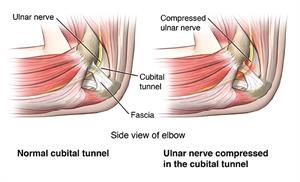- info@irosm.com
- 3333 West Commercial Blvd , Ste 101 Fort Lauderdale , Fl, 33309
(954) 751 6990
Cubital tunnel syndrome(CT-S) happens when the ulnar nerve, which passes through the cubital tunnel (a tunnel of muscle, ligament, and bone) on the inside of the elbow, becomes inflamed, swollen, and irritated.
Cubital tunnel causes pain that feels a lot like the pain you feel when you hit the “funny bone” in your elbow. The “funny bone” in the elbow is actually the ulnar nerve, a nerve that crosses the elbow. The ulnar nerve starts in the side of your neck and ends in your fingers.
Cubital tunnel syndromes may happen when a person bends the elbows often (when pulling, reaching, or lifting), leans on their elbow a lot, or has an injury to the area.
Arthritis, bone spurs, and previous fractures or dislocations of the elbow can also cause cubital tunnel syndrome.
In many cases, the cause is not known.

The following are the most common symptoms of cubital tunnel:
Numbness and tingling in the hand or ring and little finger, especially when the elbow is bent
Numbness and tingling at night
Hand pain
Weak grip and clumsiness due to muscle weakness in the affected arm and hand
Aching pain on the inside of the elbow
The symptoms of CTS may seem like other health conditions or problems, including golfer’s elbow (medial epicondylitis). Always see a healthcare provider for a diagnosis.
In addition to a complete medical history and physical exam, diagnostic tests for cubital tunnel syndrome may include:
Nerve conduction test. This test measures how fast signals travel down a nerve to find a compression or constriction of the nerve.
Electromyogram (EMG). This test checks nerve and muscle function and may be used to test the forearm muscles controlled by the ulnar nerve. If the muscles don’t work the way they should, it may be a sign that there is a problem with the ulnar nerve.
X-ray. This is done to look at the bones of the elbow and see if you have arthritis or bone spurs in your elbow.
The most effective treatment for cubital tunnel syndrome is stopping the activity that is causing the problem. Treatment may include:
Resting and stopping any activity that aggravates the condition, such as bending the elbow
A splint or foam elbow brace worn at night (to limit movement and reduce irritation)
Using an elbow pad (to protect against chronic irritation from hard surfaces)
Anti-inflammatory medicines (such as ibuprofen or naproxen)
If these treatments don’t work, the healthcare provider may talk to you about surgery. Talk to Dr. Gonzalez and the team of IROSM to discuss your options.
To prevent cubital tunnel syndrome:
Keep your arms flexible and strong.
Don’t rest on your elbows, especially on a hard surface.
Warm up before exercising or using your arms for sports or other repetitive movements.


Call : (954) 751 6990
info@irosm.com